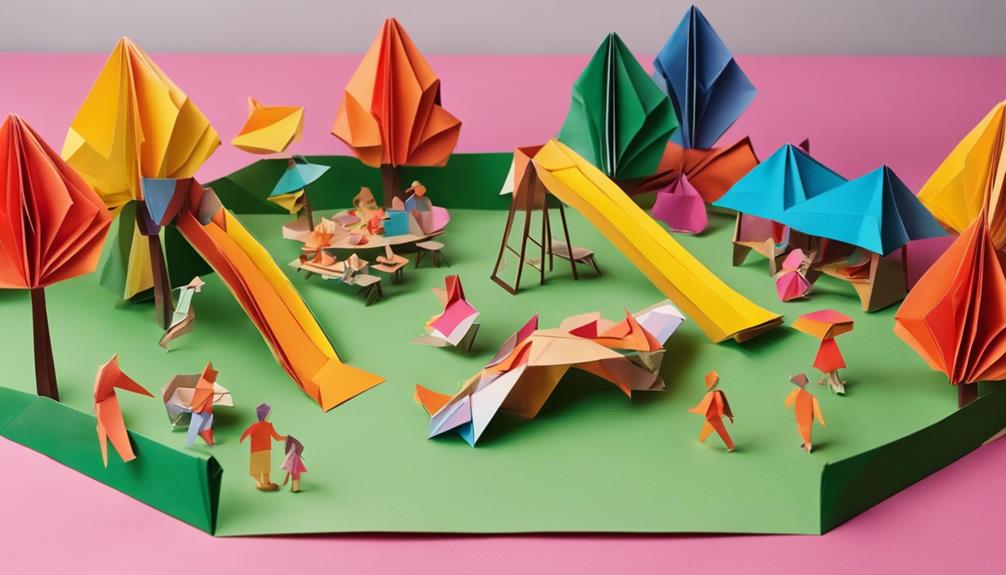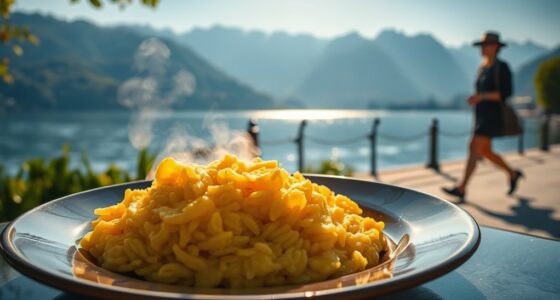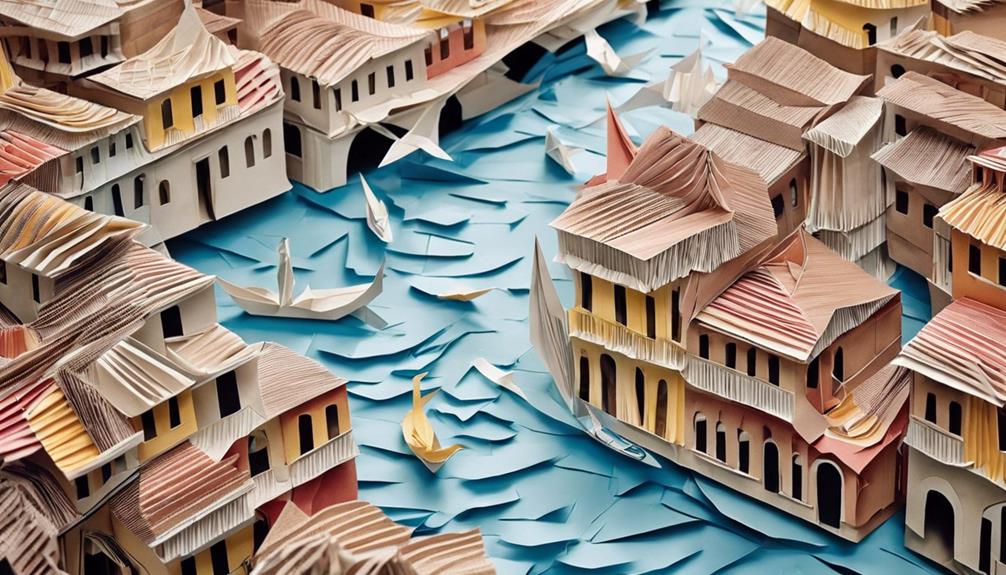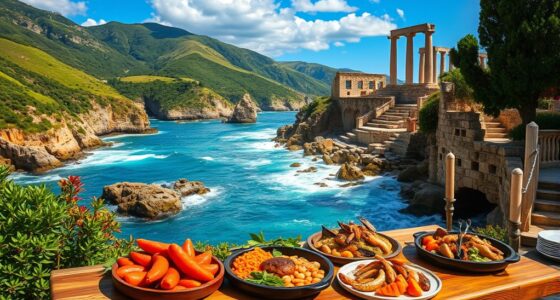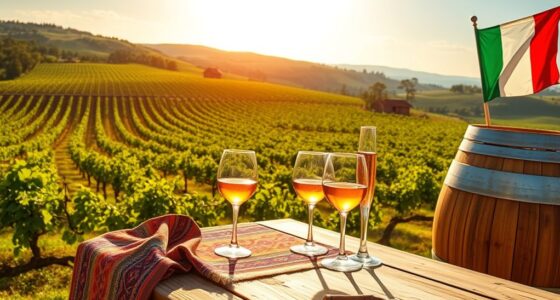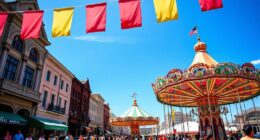Begin a journey through Italy's enchanting cities. Venice, with its romantic canals and St. Mark's Square, offers gondola rides and Byzantine architecture. Florence, birthplace of the Renaissance, boasts masterpieces and the iconic Ponte Vecchio bridge. Milan, a fashion capital, showcases the stunning Milan Cathedral and luxury shopping. Naples is known for pizza, Pompeii's ancient ruins, and the looming Mount Vesuvius. Verona, the city of Romeo and Juliet, hosts the iconic Verona Arena and rich historical sites. Each city weaves a tapestry of romance, history, and la dolce vita, inviting you to explore further.
Key Takeaways
- Venice: Romantic gondola rides and Byzantine architecture.
- Florence: Birthplace of the Renaissance with iconic artworks.
- Milan: Global fashion hub and magnificent Gothic cathedral.
- Naples: Birthplace of pizza and ancient city of Pompeii.
- Verona: City of Romeo and Juliet with iconic Verona Arena.
Venice: Canals, Gondolas, and St. Mark's
When visiting Venice, immerse yourself in the enchanting charm of its picturesque canals, romantic gondola rides, and the alluring appeal of St. Mark's Square.
The iconic St. Mark's Basilica, with its Byzantine architecture and breathtaking mosaics, stands as a testament to Venice's rich history and architectural grandeur.
Gondolas, traditional Venetian rowing boats, offer a unique way to explore the city's intricate waterways, providing a romantic and leisurely experience for visitors.
As you glide through the canals on a gondola, you can admire the historic buildings lining the water's edge and soak in the romantic atmosphere that Venice is renowned for.
St. Mark's Square, the heart of the city, beckons you with its stunning architecture and vibrant energy.
The Basilica di San Marco, with its ornate domes and intricate details, offers a glimpse into Venice's past and its artistic heritage.
Don't miss the opportunity to visit these iconic landmarks and experience the magic of Venice firsthand.
Florence: Renaissance Art and Ponte Vecchio
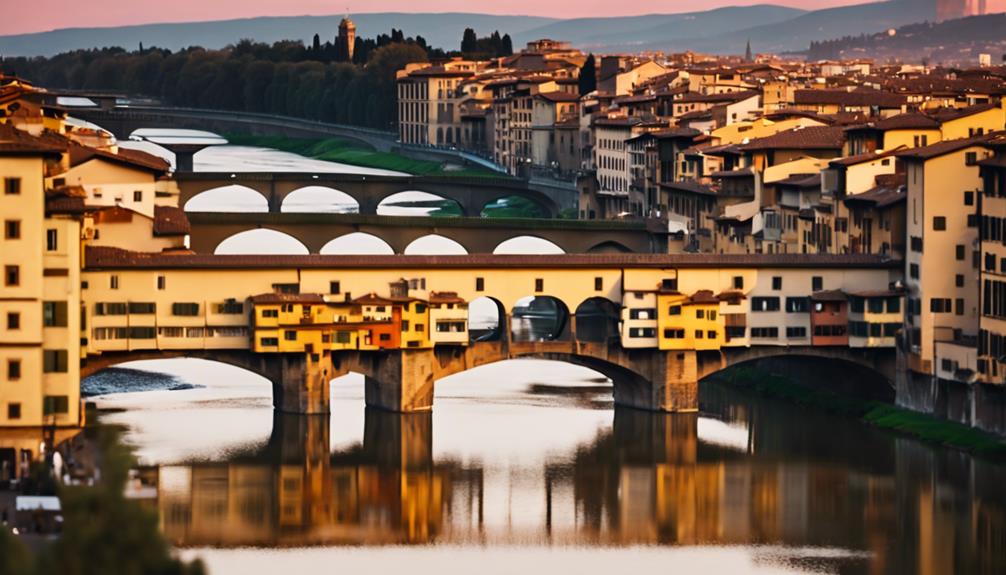
Immerse yourself in Florence's rich artistic legacy and vibrant culture, where Renaissance masterpieces and the iconic Ponte Vecchio bridge await your exploration.
- Renaissance Art:
Florence, known as the birthplace of the Renaissance, boasts renowned artworks by masters like Michelangelo, Leonardo da Vinci, and Botticelli. The city's museums and galleries preserve these treasures, offering a glimpse into this transformative period in art history.
- Ponte Vecchio:
The Ponte Vecchio, a medieval bridge spanning the Arno River, is a unique attraction in Florence. Its iconic feature is the shops that line the bridge, selling jewelry, art, and souvenirs. This bustling bridge isn't just a crossing point but a cultural hub in the heart of the city.
- Baroque Influence:
In addition to its Renaissance heritage, Florence also showcases stunning Baroque architecture in its churches and palaces. The blend of Renaissance and Baroque styles creates a visual tapestry that adds to the city's allure, making it a paradise for art enthusiasts and history lovers alike.
Milan: Fashion, Design, and Duomo
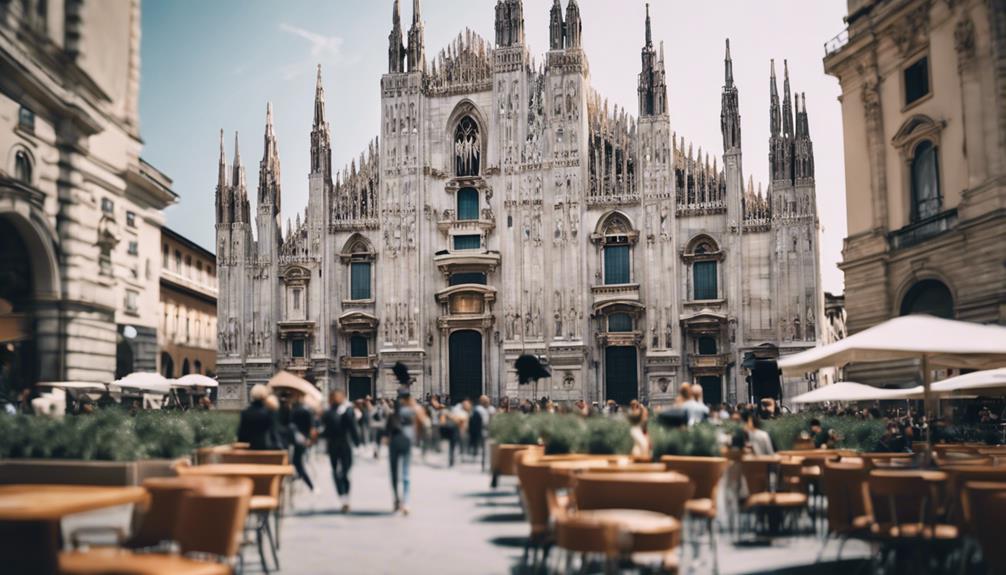
What makes Milan stand out as the fashion and design capital of Italy? Milan's reputation as a global fashion hub is solidified by events like Milan Fashion Week, where top designers showcase their latest creations. The city's Quadrilatero della Moda district is a haven for luxury shopping, with renowned brands like Gucci, Prada, and Versace lining the streets. In addition to its fashion prowess, Milan is home to the magnificent Milan Cathedral, also known as the Duomo di Milano. This Gothic masterpiece is one of the largest cathedrals globally, boasting intricate details and stunning architecture. To explore further into Milan's allure, let's examine a comparison between Milan Cathedral and Milan Fashion Week:
| Milan Cathedral | Milan Fashion Week |
|---|---|
| – Iconic Gothic cathedral | – Prestigious fashion event |
| – Intricate architecture | – Showcases top designers |
| – Rich history and cultural significance | – Sets global fashion trends |
| – Houses Leonardo da Vinci's The Last Supper | – Attracts fashion enthusiasts worldwide |
Naples: Pizza, Pompeii, and Vesuvius

Naples, renowned as the birthplace of pizza, Pompeii, and Vesuvius, offers a mesmerizing blend of culinary delights, ancient history, and natural wonders.
- Pizza:
The traditional Neapolitan style of pizza, with its thin crust, fresh ingredients, and wood-fired cooking method, has been designated as a UNESCO cultural heritage. When in Naples, don't miss the chance to taste an authentic Margherita pizza, named after Queen Margherita of Savoy.
- Pompeii:
The ancient city of Pompeii, tragically buried under volcanic ash by the eruption of Mount Vesuvius in 79 AD, stands frozen in time, offering visitors a unique glimpse into Roman life with remarkably preserved ruins, including homes, baths, and even street layouts.
- Mount Vesuvius:
This active volcano, overlooking Naples, last erupted in 1944. Despite its destructive history, it remains a thrilling hiking destination for adventurous travelers seeking panoramic views of the Bay of Naples and the surrounding landscape. Remember to check for any safety advisories before planning your visit.
Verona: Romeo, Juliet, and Arena

Verona, famously known as the city of Romeo and Juliet, attracts visitors worldwide to see the iconic balcony associated with Shakespeare's tragic love story.
Additionally, the Verona Arena, a well-preserved Roman amphitheater, serves as a prominent venue for opera performances and music concerts, drawing in thousands of spectators each year.
These historical and cultural landmarks in Verona offer a blend of romance, history, and artistic experiences for travelers seeking to immerse themselves in the city's rich heritage.
Shakespeare's Beloved Characters
Immerse yourself in the world of Shakespeare's beloved characters as you explore the enchanting city of Verona, where Romeo, Juliet, and the historic Arena bring the timeless tale to life.
Verona, known as the backdrop for the tragic love story of Romeo and Juliet, captivates visitors with its romantic allure and historical charm. Here, you can visit Juliet's House, complete with the iconic balcony where Juliet is said to have declared her love for Romeo. The city's streets echo with the echoes of the famous lovers, drawing in tourists from around the globe to experience the magic of their story firsthand.
- Discover the legendary Juliet's House, where you can stand on the balcony that inspired Shakespeare's immortal words.
- Explore the romantic ambiance of Verona through guided tours that showcase the key locations from the play.
- Immerse yourself in the cultural scene at Verona's Arena, a well-preserved Roman amphitheater that hosts world-class opera performances and concerts.
Iconic Verona Amphitheater
With its origins dating back to the 1st century AD, the Verona Arena stands as an iconic symbol of ancient Roman architecture and cultural heritage. This well-preserved Roman amphitheater is the third-largest of its kind globally, showcasing the architectural marvels of the Roman empire.
Hosting operas and concerts, the Verona Arena continues to captivate audiences with its enduring cultural significance. Serving as the backdrop for Shakespeare's tragic tale of Romeo and Juliet, the arena adds a romantic allure to its historical importance.
Accommodating approximately 30,000 spectators, the Verona Arena remains a popular venue for large-scale events and performances, solidifying its place as one of Italy's most remarkable landmarks.
Recognized as a UNESCO World Heritage Site, this ancient structure stands as a reflection of the incredible engineering and architectural prowess of the Romans, solidifying its status as one of the world's architectural Wonders of the World.
Sicily: Palermo, Taormina, and Mount Etna

Discover the enchanting allure of Sicily through its vibrant capital of Palermo, the picturesque hilltop town of Taormina, and the majestic presence of Mount Etna.
- Palermo: Immerse yourself in the bustling streets of Palermo, where vibrant street markets offer a glimpse into Sicily's rich culinary traditions. Explore the historic architecture, such as the stunning Palermo Cathedral, a masterpiece blending Norman, Moorish, and Byzantine styles. Don't miss out on tasting the delicious street food like arancini and cannoli, which are local favorites.
- Taormina: Wander through the charming cobblestone streets of Taormina and marvel at the breathtaking views of the Ionian Sea from the ancient Greek theater. This picturesque hilltop town exudes a romantic atmosphere, with its well-preserved architecture and lush gardens. Take a stroll along Corso Umberto, lined with boutique shops and quaint cafes, offering a perfect blend of relaxation and cultural exploration.
- Mount Etna: Experience the awe-inspiring presence of Mount Etna, one of the world's most active volcanoes. Embark on a unique hiking adventure to witness the volcanic activity up close and admire the panoramic views of the Sicilian landscape. Explore the diverse flora and fauna that thrive in the volcanic soil, creating a surreal and enthralling environment.
Frequently Asked Questions
What Is La Dolce Vita in Italy?
In Italy, 'La Dolce Vita' translates to 'the sweet life.' It embodies a lifestyle of luxury, pleasure, and indulgence.
The term represents a carefree and glamorous way of living, often associated with elegance, sophistication, and enjoyment of life's pleasures.
From exquisite cuisine to beautiful landscapes, 'La Dolce Vita' captures the essence of savoring every moment and embracing the finer things in life.
Why Is La Dolce Vita so Famous?
La Dolce Vita gained fame due to Fellini's 1960 film, showcasing a life of luxury and pleasure in Rome. The movie depicted scenes of alienation, despair, and decadence, capturing the essence of Rome's glamorous lifestyle.
Iconic locations like the Trevi Fountain further solidified Rome as the epitome of La Dolce Vita. Souvenirs inspired by the film remain popular among visitors, perpetuating the allure of this glamorous and indulgent lifestyle.
Why Was La Dolce Vita Banned?
The film 'La Dolce Vita' was banned in some regions due to its controversial themes, such as decadence, alienation, and critiques of societal norms.
Scenes depicting hedonistic lifestyles and scandals were deemed inappropriate for public viewing.
The exploration of moral decay and existential crisis challenged established values, leading to debates on freedom of expression in cinema.
These factors collectively contributed to the decision to ban 'La Dolce Vita' in certain countries.
What Does La Dolce Vita Symbolize?
La Dolce Vita symbolizes a life of luxury and pleasure. It embodies a glamorous and indulgent lifestyle often associated with Rome and Italian culture.
The term became synonymous with Rome after the release of Fellini's 1960 film, capturing the essence of a lavish and extravagant existence.
Trevi Fountain in Rome further romanticizes this notion with its allure and legends, reflecting the opulence and allure of 'La Dolce Vita.'
Conclusion
To sum up, Italy's cities offer a perfect blend of romance, history, and the sweet life. From Venice's iconic canals to Naples' delicious pizza, each destination has its own unique charm.
Whether you're exploring Florence's Renaissance art or admiring Milan's fashion scene, there's something for everyone to enjoy.
So pack your bags, immerse yourself in the culture, and let Italy's beauty captivate you. A trip to Italy is sure to be an unforgettable experience.


